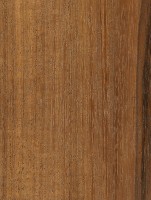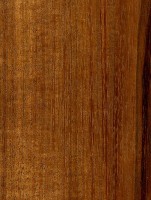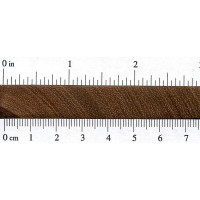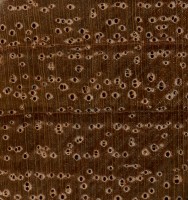 |
Common Name(s): Tzalam, Caribbean Walnut, Sabicu, False Tamarind Scientific Name: Lysiloma spp. (L. bahamense and L. latisiliquum) Distribution: Mexico and Central America Tree Size: 50-65 ft (15-20 m) tall, 2-3 ft (.6-1 m) trunk diameter Average Dried Weight: 49 lbs/ft3 (780 kg/m3) Specific Gravity (Basic, 12% MC): .63, .78 Janka Hardness: 1,400 lbf (6,230 N) Modulus of Rupture: 12,800 lbf/in2 (88.3 MPa) Elastic Modulus: 1,900,000 lbf/in2 ( 13.10 GPa) Crushing Strength: No data available Shrinkage: Radial: 2.7%, Tangential: 7.2%, Volumetric: 9.5%, T/R Ratio: 2.7 |
Color/Appearance: Heartwood light to medium brown, sometimes with a reddish or purplish hue. Darker brown streaks common. Thin sapwood is a pale grayish white, clearly demarcated from heartwood. Sometimes seen with curly grain patterns.
Grain/Texture: Straight grain with an open, uniform texture. Medium luster.
Endgrain: Diffuse-porous; large pores in no specific arrangement, few to very few; solitary and radial multiples of 2-3; heartwood deposits occasionally present; narrow rays not visible without lens, normal spacing; parenchyma vasicentric, lozenge, confluent, and banded (marginal).
Rot Resistance: Reported to be very durable, and also resistant to most insect attacks.
Workability: Overall working properties are good, though Tzalam may blunt tool edges faster than usual. Turns, glues, and finishes well. Able to take a high natural polish.
Odor: No characteristic odor.
Allergies/Toxicity: Although severe reactions are quite uncommon, Tzalam has been reported to cause cold-like symptoms. See the articles Wood Allergies and Toxicity and Wood Dust Safety for more information.
Pricing/Availability: Prices likely to be moderate for an imported tropical species. Boards with curly grain or other figure are likely to be considerably more expensive.
Sustainability: This wood species is not listed in the CITES Appendices or on the IUCN Red List of Threatened Species.
Common Uses: Flooring, exterior furniture, interior trim, veneer, turned objects, and other small, specialty wood items.
Comments: Perhaps due to its somewhat obscure and strangely spelled common name, Tzalam is sometimes marketed as “Caribbean Walnut,” though it bears little relation to the true walnuts in the Juglans genus. Appearance-wise, Tzalam can closely resemble Koa. Fluorescent.
None available.








I got 90’ of 8/8 quite cheaply to make a prototype Stickley loveseat for my son. The wood is beautiful and smooth planes to a fine luster, the downside is it blunts tools quickly and dulls carbide resaw blades extraordinarily fast. I won’t use it again.
I made an electric guitar and bass, using Tzalam as fingerboard, the wood is beautiful and very strong, I think it’s fairly difficult to work with and carve. Is it me or it smells a little bit like cheese when cut?
This is a beautiful wood. It looks a lot like walnut but with a red hue. It is hard and its dust makes you sneeze. It is frequent to find pieces with a lot of inner stress that develop great movement after sawing. That is why I tend to use it mostly for shorter pieces than 1m or 3-4 ft
Other times the wood is just perfectly stable but it is difficult to know what you are getting ahead.
I recently bought some 2″ x 8″ Tzalam. I resawed the 2″ in half to 1″. I would say half of what I resawed had so much inner tension some of the boards literally exploded in my hand. With severe cracking all the way across the grain on some boards. The results had terrible wind, warp and curve so much so that probably half of what I resawed was unusable. (I guess I could joint it down to 3/8″ but what a waste. It is a real shame because the wood is beautiful. Next time I will just buy 1″… Read more »
I don’t think they are drying that beautiful wood properly. Very frequently the 1″ stock piles look all crooked, so I assume some measures are not being taken to provide flat consistent stock. I am in Mexico too.
I am in Merida and plan to work with some tzalam. How is it to work? pilot holes for screws of course. I recently worked with some zapote and it is the hardest wood I have ever encountered
I built a shower bench out of tzalam. All joinery was 3/8″ counter sinks, pilot holes, epoxied screwed and plugged. It is tough wood but I enjoyed working with it. Finishes beautifully.